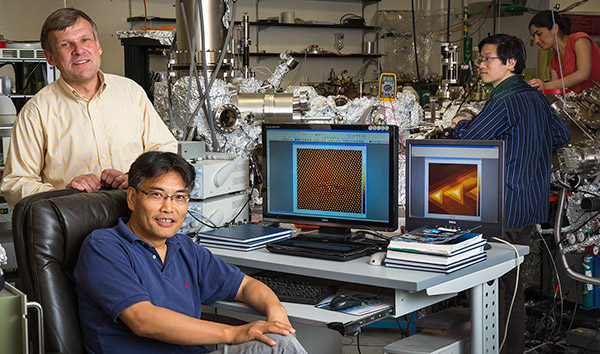
Recent research into the electronic properties of new materials, called topological insulators (TIs), shows that ultra-thin films of TI have promising characteristics to bring quantum computing one step closer to reality.
An ongoing collaboration between physicists from the University of Wisconsin-Milwaukee (UWM) and the University of York, UK, is focused on probing, tailoring and tuning the electronic behaviors of TIs at nanoscale.
In bulk these materials do, in fact, insulate. But on the surface, TIs are conductors. Like the efficient conductor graphene, the scientists are trying to determine the best way to control the electrons’ movement and behavior in TIs – and integrate them with semiconductors and superconductors.

“The electrons on the surface of topographical insulators have some intriguing properties. It’s very similar to graphene,” says UWM Physics Professor Lian Li, principal investigator for the National Science Foundation grant supporting the research.
These properties make TIs well suited for spintronics, an emerging field of nanoscale electronics that involve the manipulation of the electron spin as well as its charge.
The scientists’ recent work has shown that the quantum properties of the electrons are modified, but not destroyed by intrinsic imperfections, called grain boundaries, on the surface of ultra-thin layers of bismuth and selenium, Bi2Se3.
The work was featured on the cover of a recent issue of the journal Physical Review Letters.
“We need to understand how to engineer these defects so that we can control the electronic properties of TI if the dream of quantum computing is to become a reality,” says Vlado Lazarov, a physicist at York.
Spintronics take advantage of the fact that electrons have spin, and the orientation of the spin can be used to greatly speed data transfer and increase computing storage capacity – if the spins can be manipulated. The advantage in TIs is that the spin of the metallic surface states is “locked” perpendicular to the direction of the electron motion.
The discovery of how these defects modify – but do not destroy – the special properties of the electrons at the surface of the TI is only a first step in uncovering the full story of the electron behaviors on such thin films, says Michael Weinert, UWM Distinguished Professor of Physics and director of the Laboratory for Surface Studies.
“The importance of these properties for future electronic devices is that the resistance should be very low, making for energy-efficient devices,” says Weinert. “If you can control the spin then you can create more complicated devices.”







